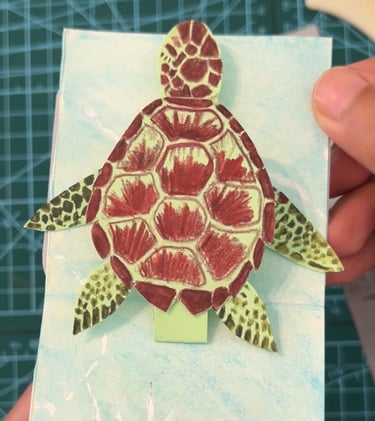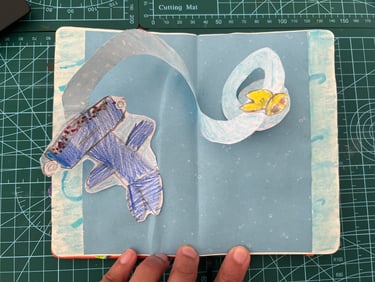A. Promote real intelligence of nature
B. Individual centered education as a human right
Visions
Story behind Pop Unfold's - Why?
'Why should we take care of the environment and climate change, when it all looks so bad. We are as it is going to die one day. Wouldn't it be a better idea to consume a lot, until it all lasts?"
This is what my eldest son had expressed at 7 years of age - after some deep thoughts he was in one evening.
We have had (and still do) a conscious consumption household - buy quality and what we need. I was studying Environment and planning at Roskilde University that time. Discussions and actions for earth welfare were intense.
I realised that instead of hope and search for solutions, there was hopelessness for the situation. Instead of all the beauty and robust systems of Nature that exists, the child had absorbed the doom of it all.
I thought to myself "What if this is the notion majority of populations act from?" It was a valid point after all! With the limited time available in everyday's fast life and limited life that each human has!
That was the beginning of my search for hope seeding activities. I want the coming generations to look at the stunning beauty that exists in every element in Nature, no two the same, the patterns, the symmetry, the colours, the complexity and the absolute simplicity it all exists with. To get present in the now. To look at the robust, the evolving and ones needing support. To look for solutions in all that exists - to share and create community around the nature now.
While I was looking for an connecting Nature, education and play, I came across Silvia Hijano's paper pop up engineering courses at Domestika. In one of them she shared creations of stunning Nature inspired paper pop ups.
I was blown away! She had illustrated and designed 3D flat folding elements, recreating the essense of each - it captured her outdoor time in a book, that came alive when re-opened! I was hooked! That was it! The combination of outdoor tour with a hands-on, playful geometry creation! I knew paper-pop-ups were used in STEM education, especially in mathematics and engineering fields already. 3D books are also known to be mesmerising and attention retaining for all ages - they are magical when elements come out from flat folded pages!
I then got onto learning the basics of paper engineering and observing nature as the real pop ups they are. With lots of studying structures, practicing, problem solving & brain racking. I now study nature elements with mathematics and geometry, scanning for possibilities of recreations by different ages, and I thereafter simplify them into blank paper templates.
Each template, is an invitation to get up close to Nature, expressions of which, will hopefully keep unfolding.
- Sakina






B. What is 10 years of conscious, curious and absorbing presence really worth?
Not in terms of grades or checklists.
But in the wiring of a child's inner voice. In how they learn to respond to challenge. In how they begin to see themselves inside the world, not just surviving in it, but shaping it. From the moment a child becomes aware of themselves, the data starts flowing. Not numbers, but experiences. Contact points.
I often find myself tracing back the moments that shaped me, as a student and as a person. The spaces I was placed in. The way I was spoken to. The permission I felt, or didn’t feel. To ask questions, to explore, to be wrong.
In India, my education was rooted in structure. There was discipline, order, a deep sense of respect for authority. But alongside that came something quieter. A wiring that told me my value was measured in performance. That the right answer mattered more than the wondering. That success meant scoring well, not thinking differently.
It wasn’t until years later, in Denmark, that I encountered a completely different approach. The Scandinavian model, with its trust in student's instincts, its spaciousness for play, its quiet confidence that learning happens best when it’s lived/ chosen, not forced. Here, teachers weren’t towering figures. They were collaborators. Enablers of curiosity. Mistakes weren’t failures; they were invitations to understand.
It struck me then: education isn’t just a method. It’s a message. And children absorb that message long before they can articulate it.
Ten years of early consciousness, from the moment a child begins to form a sense of self - is more than a phase. It’s a neurological and emotional blueprint. Those are the years when belief systems are planted. When resilience, self-trust, and relational habits are etched into the brain’s pathways. Modern neuroscience confirms what educators like Montessori and those in Nordic systems have known intuitively: that the brain is astonishingly malleable in those early years. And that the environment we place around a child - physically, emotionally, socially, becomes their internal environment later.
The contrast between my experiences in India and Denmark is not about which system is better, it's about awareness. It's about asking how intentional we are with the how of education. Because that how becomes the how much of a person’s belief in themselves.
So what is 10 years of that worth?
Everything.
Because it shows up in boardrooms, in brainstorms, in how someone leads with humility or listens with presence.
Education, shouldn't be the only aspect to be a human right - 'the how and how much of education impartment' should be too. Because education isn’t a pipeline. It’s a landscape.
Let’s connect the dots between childhood experiences and adult capacities.
What we plant in those first ten years, that’s what grows the future forests.
A. Nature's very own revolution is in the details
Nature is astonishing. Its resilience humbles me every day. I often find myself whispering “How strong!” when I see a plant breaking through pavements or cracks in the road. That is resilience in its purest form.
Growing up in India, I never heard the word “weeds.” To us, all nature was nature. Every leaf, every sprout, every wild bloom was a delight - may be because it was rare in the concrete sprawl. When I later encountered the term “weed,” it puzzled me.
Who decided what counts as a “weed”?
On what basis were certain plants dismissed?
And what of those with medicinal, edible, or ecological value?
The truth is: in nature, nothing is wasted. Every single element, from moss to mushrooms, from wildflowers to “weeds”, plays a role in the cycle of life. If we look closely, the intelligence is undeniable: the colours, the transformations, the intricate ways species interact and adapt. Nothing exists in isolation. Everything exists in tandem.
This is what I mean when I speak of Real Intelligence (RI) - the intelligence of nature. Vast, intricate, and still so much of it unknown.
It is the curiosity and appreciation towards the known and the unknown Nature, that Pop Unfold visions to achieve.